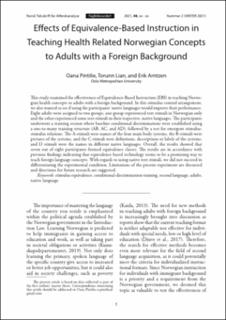Effects of Equivalence-Based Instruction in Teaching Health Related Norwegian Concepts to Adults with a Foreign Background
Peer reviewed, Journal article
Published version
Permanent lenke
https://hdl.handle.net/11250/2838193Utgivelsesdato
2021Metadata
Vis full innførselSamlinger
Originalversjon
Norsk Tidsskrift for Atferdsanalyse (NTA). 2021, 48 (2), . http://www.nta.atferd.no/journalissue.aspx?IdDocument=986Sammendrag
This study examined the effectiveness of Equivalence-Based Instruction (EBI) in teaching Norwegian health concepts to adults with a foreign background. In this stimulus control arrangement, we also wanted to see if using the participants’ native languages would improve their performance. Eight adults were assigned to two groups, one group experienced text stimuli in Norwegian only and the other experienced some text stimuli in their respective, native languages. The participants underwent a training session where baseline conditional discriminations were established using a one-to-many training structure (AB, AC, and AD), followed by a test for emergent stimulus-stimulus relations. The A-stimuli were names of the four main body systems, the B-stimuli were pictures of the systems, and the C stimuli were definitions, descriptions or labels of the systems, and D stimuli were the names in different native languages. Overall, the results showed that seven out of eight participants formed equivalence classes. The results are in accordance with previous findings indicating that equivalence based technology seems to be a promising way to teach foreign language concepts. With regards to using native text stimuli, we did not succeed in differentiating the experimental condition. Limitations of the present experiment are discussed and directions for future research are suggested.
